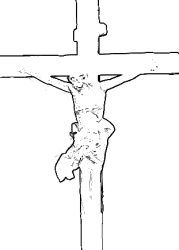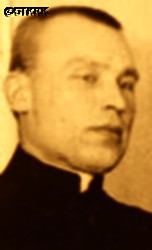Roman Catholic
St Sigismund parish
05-507 Słomczyn
85 Wiślana Str.
Konstancin deanery
Warsaw archdiocese, Poland
full list:
displayClick to display full list

searchClick to search full list by categories
wyświetlKliknij by wyświetlić pełną listę po polsku

szukajKliknij by przeszukać listę wg kategorii po polsku

Martyrology of the clergy — Poland
XX century (1914 – 1989)
personal data
surname
KRUŠA
forename(s)
Anthony (pl. Antoni)
forename(s)
versions/aliases
Antanas

function
diocesan priest
creed
Latin (Roman Catholic) Church RCmore on
en.wikipedia.org
[access: 2014.09.21]
diocese / province
Telsiai diocesemore on
en.wikipedia.org
[access: 2014.12.20]
Territorial Prelature of Klaipeda/Memelmore on
www.catholic-hierarchy.org
[access: 2024.03.02]
academic distinctions
Doctor of Theology
honorary titles
honorary canonmore on
en.wikipedia.org
[access: 2014.11.14]
nationality
Lithuanian
date and place
of death
23.11.1952

ITL KargopolLagGuLAG slave labour camp network
today: Yertsevo, Konoshsky reg., Arkhangelsk oblast, Russia
more on
en.wikipedia.org
[access: 2023.02.22]
details of death
After end of hostilities of the World War II, started by German and Russian invasion of Poland in 09.1939, after start of Russian occupation of Lithuania in 1944/1945, arrested on 18.09.1950 (according to some sources in 1947) by the Russians in his apartment in Telšiai (or in Kaunas).
On 07.04.1951, pursuant to Art. 58‐10 p. 2 of the Penal Code, sentenced to 10 years of slave labour in Russian concentration camps Gulag.
On 08.06.1951 brought to Russian slave labour concentration camp ITL KargopolLag in Arkhangelsk oblast.
Totally exhausted and ill, transported to the camp hospital in Yertsevo.
There perished.
alt. details of death
There are indications that during the German occupation hid a Jewish woman.
cause of death
extermination
perpetrators
Russians
sites and events
ITL KargopolLagClick to display the description, GulagClick to display the description, Help to the JewsClick to display the description, Ribbentrop‐MolotovClick to display the description, Pius XI's encyclicalsClick to display the description
date and place
of birth
1900

Gorainiaitoday: Vainutas eld., Šilutė dist., Klaipėda Cou., Lithuania
more on
lt.wikipedia.org
[access: 2020.07.31]
presbyter (holy orders)
ordination
1925

positions held
c. 1945 – c. 1950
professor — Kaunastoday: Kaunas city dist., Kaunas Cou., Lithuania
more on
en.wikipedia.org
[access: 2022.06.29] ⋄ Theological Seminary — lecturer of Latin, history, moral theology, pedagogy
till 1945
professor — Telšiaitoday: Telšiai urban eld., Telšiai dist., Telšiai Cou., Lithuania
more on
en.wikipedia.org
[access: 2022.01.06] ⋄ Theological Seminary — lecturer of Latin, history, moral theology, pedagogy (till the closure of the seminary by the Russian occupier)
1936 – 1938
prefect — Klaipėdaform.: Memel
today: Klaipėda city dist., Klaipėda Cou., Lithuania
more on
en.wikipedia.org
[access: 2022.06.29] ⋄ Pedagogical Institute — also: deputy official (i.e. bishop's judicial vicar) of the Territorial Prelature of Klaipeda/Memel
prefect — Telšiaitoday: Telšiai urban eld., Telšiai dist., Telšiai Cou., Lithuania
more on
en.wikipedia.org
[access: 2022.01.06] ⋄ Bishop Matthias Wołonczewski's gymnasium
priest — (United States of America territory)today: United States of America
more on
en.wikipedia.org
[access: 2022.08.05]
PhD student — Rometoday: Rome prov., Lazio reg., Italy
more on
en.wikipedia.org
[access: 2021.12.18] ⋄ theology
author of i.a. Lit. „Natūralizmas ir lietuvių literatūra” (Eng. „Naturalism and Lithuanian literature”)
sites and events
descriptions
ITL KargopolLag: Russian Rus. Исправи́тельно‐Трудово́й Ла́герь (Eng. Corrective Labor Camp) ITL Rus. Каргопольский (Eng. Kargopolsky) — concentration and slave forced labor camp (within the Gulag complex) — with headquarters in the city of Kargopol, and then Yercevo station on the northern railway line, Arkhangelsk Oblast. Founded on 16.08.1937. The camp units were located along the railway road. Prisoners slaved in forest clearing, construction of a pulp factory on the Voloshka River, wood processing (supplied as firewood to Moscow, for renovation works, railway sleepers, etc.), ski production, sawmills, food production in local collective farms, in furniture, clothing and footwear production plants, at loading and unloading goods, in the construction of branch railway lines, narrow‐gauge railways, roads, in mechanical and repair plants and workshops, in brick kilns. At its peak, c. 30,000 prisoners were held there: e.g. 30,069 (01.01.1939); 27,432 (01.01.1940); 25,218 (01.01.1941); 24,295 (01.07.1941); 24,892 (01.01.1943); 21,239 (01.01.1948); 20,237 (01.01.1950); 23,305 (01.01.1952); 25,540 (01.01.1953). In total, c. 300,000 people passed through it, with the mortality rate reaching 20% of the detained prisoners. It ceased operations in 1960. (more on: www.gulagmuseum.orgClick to attempt to display webpage
[access: 2014.05.09])
Gulag: The acronym Gulag comes from the Rus. Главное управление исправительно‐трудовых лагерей и колоний (Eng. Main Board of Correctional Labor Camps). The network of Russian concentration camps for slave labor was formally established by the decision of the highest Russian authorities on 27.06.1929. Control was taken over by the OGPU, the predecessor of the genocidal NKVD (from 1934) and the MGB (from 1946). Individual gulags (camps) were often established in remote, sparsely populated areas, where industrial or transport facilities important for the Russian state were built. They were modeled on the first „great construction of communism”, the White Sea‐Baltic Canal (1931‐1932), and Naftali Frenkel, of Jewish origin, is considered the creator of the system of using forced slave labor within the Gulag. He went down in history as the author of the principle „We have to squeeze everything out of the prisoner in the first three months — then nothing is there for us”. He was to be the creator, according to Alexander Solzhenitsyn, of the so‐called „Boiler system”, i.e. the dependence of food rations on working out a certain percentage of the norm. The term ZEK — prisoner — i.e. Rus. заключенный‐каналоармец (Eng. canal soldier) — was coined in the ITL BelBaltLag managed by him, and was adopted to mean a prisoner in Russian slave labor camps. Up to 12 mln prisoners were held in Gulag camps at one time, i.e. c. 5% of Russia's population. In his book „The Gulag Archipelago”, Solzhenitsyn estimated that c. 60 mln people were killed in the Gulag until 1956. Formally dissolved on 20.01.1960. (more on: en.wikipedia.orgClick to attempt to display webpage
[access: 2024.04.08])
Help to the Jews: During World War II on the Polish occupied territories Germans forbid to give any support to the Jews under penalty of death. Hundreds of Polish priests and religious helped the Jews despite this official sanction. Many of them were caught and murdered.
Ribbentrop‐Molotov: Genocidal Russian‐German alliance pact between Russian leader Joseph Stalin and German leader Adolf Hitler signed on 23.08.1939 in Moscow by respective foreign ministers, Mr. Vyacheslav Molotov for Russia and Joachim von Ribbentrop for Germany. The pact sanctioned and was the direct cause of joint Russian and German invasion of Poland and the outbreak of the World War II in 09.1939. In a political sense, the pact was an attempt to restore the status quo ante before 1914, with one exception, namely the „commercial” exchange of the so‐called „Kingdom of Poland”, which in 1914 was part of the Russian Empire, fore Eastern Galicia (today's western Ukraine), in 1914 belonging to the Austro‐Hungarian Empire. Galicia, including Lviv, was to be taken over by the Russians, the „Kingdom of Poland” — under the name of the General Governorate — Germany. The resultant „war was one of the greatest calamities and dramas of humanity in history, for two atheistic and anti‐Christian ideologies — national and international socialism — rejected God and His fifth Decalogue commandment: Thou shall not kill!” (Abp Stanislav Gądecki, 01.09.2019). The decisions taken — backed up by the betrayal of the formal allies of Poland, France and Germany, which on 12.09.1939, at a joint conference in Abbeville, decided not to provide aid to attacked Poland and not to take military action against Germany (a clear breach of treaty obligations with Poland) — were on 28.09.1939 slightly altered and made more precise when a treaty on „German‐Russian boundaries and friendship” was agreed by the same murderous signatories. One of its findings was establishment of spheres of influence in Central and Eastern Europe and in consequence IV partition of Poland. In one of its secret annexes agreed, that: „the Signatories will not tolerate on its respective territories any Polish propaganda that affects the territory of the other Side. On their respective territories they will suppress all such propaganda and inform each other of the measures taken to accomplish it”. The agreements resulted in a series of meeting between two genocidal organization representing both sides — German Gestapo and Russian NKVD when coordination of efforts to exterminate Polish intelligentsia and Polish leading classes (in Germany called «Intelligenzaktion», in Russia took the form of Katyń massacres) where discussed. Resulted in deaths of hundreds of thousands of Polish intelligentsia, including thousands of priests presented here, and tens of millions of ordinary people,. The results of this Russian‐German pact lasted till 1989 and are still in evidence even today. (more on: en.wikipedia.orgClick to attempt to display webpage
[access: 2015.09.30])
Pius XI's encyclicals: Facing the creation of two totalitarian systems in Europe, which seemed to compete with each other, though there were more similarities than contradictions between them, Pope Pius XI issued in 03.1937 (within 5 days) two encyclicals. In the „Mit brennender Sorge” (Eng. „With Burning Concern”) published on 14.03.1938, condemned the national socialism prevailing in Germany. The Pope wrote: „Whoever, following the old Germanic‐pre‐Christian beliefs, puts various impersonal fate in the place of a personal God, denies the wisdom of God and Providence […], whoever exalts earthly values: race or nation, or state, or state system, representatives of state power or other fundamental values of human society, […] and makes them the highest standard of all values, including religious ones, and idolizes them, this one […] is far from true faith in God and from a worldview corresponding to such faith”. On 19.03.1937, published „Divini Redemptoris” (Eng. „Divine Redeemer”), in which criticized Russian communism, dialectical materialism and the class struggle theory. The Pope wrote: „Communism deprives man of freedom, and therefore the spiritual basis of all life norms. It deprives the human person of all his dignity and any moral support with which he could resist the onslaught of blind passions […] This is the new gospel that Bolshevik and godless communism preaches as a message of salvation and redemption of humanity”… Pius XI demanded that the established human law be subjected to the natural law of God , recommended the implementation of the ideal of a Christian state and society, and called on Catholics to resist. Two years later, National Socialist Germany and Communist Russia came together and started World War II. (more on: www.vatican.vaClick to attempt to display webpage
[access: 2023.05.28], www.vatican.vaClick to attempt to display webpage
[access: 2023.05.28])
sources
personal:
www.varniai-museum.ltClick to attempt to display webpage
[access: 2018.09.02], lkbkronika.ltClick to attempt to display webpage
[access: 2021.12.19]
original images:
www.varniai-museum.ltClick to attempt to display webpage
[access: 2018.09.02]
LETTER to CUSTODIAN/ADMINISTRATOR
If you have an Email client on your communicator/computer — such as Mozilla Thunderbird, Windows Mail or Microsoft Outlook, described at WikipediaPatrz:
en.wikipedia.org, among others — try the link below, please:
LETTER to CUSTODIAN/ADMINISTRATORClick and try to call your own Email client
If however you do not run such a client or the above link is not active please send an email to the Custodian/Administrator using your account — in your customary email/correspondence engine — at the following address:

giving the following as the subject:
MARTYROLOGY: KRUŠA Anthony
To return to the biography press below:
 Click to return to biography
Click to return to biography








